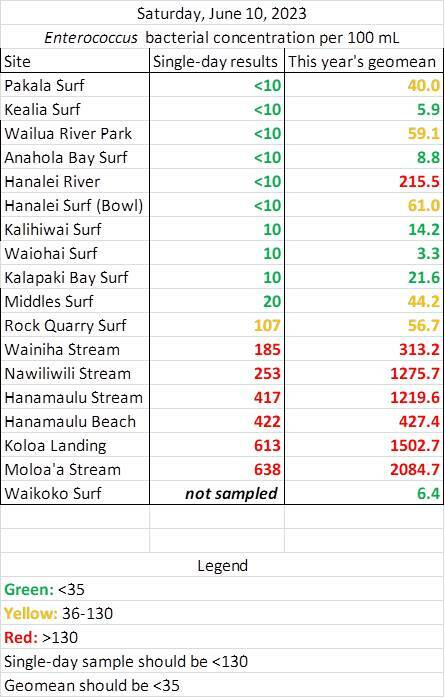LIHU‘E — The dry season has been kind to Kaua‘i’s waters, as low rainfall protected much of the island’s surf spots from runoff pollution this month, according to Surfrider Kaua‘i’s Blue Water Task Force.
Every month, the task force analyzes samples of streams, rivers and surf spots across the island to check for the enterococcus bacterium, a federally recognized indicator of fecal presence in water.
The team’s June water report has been this year’s most positive, with eight out of nine tested surf spots — Pakala, Kealia, Anahola Bay, Hanalei Bowl, Kalihiwai, Waiohai, Kalapaki and Middles — showing low bacteria counts, measuring below 35 enterococci per 100 milliliters of water. Wailua River Park also showed a low bacteria count, as did the Hanalei River, which has tested below state water quality standards every month since February 2022.
Even this month’s most polluted surf spot, Rock Quarry Surf, still came in above state standards at 107 enterococci per 100 milliliters of water.
Surfrider Kaua‘i senior scientist Carl Berg attributes this to the month’s minimal rainfall.
“With the rainy season over, we are getting less surface runoff, and our waters look clearer and generally have less bacteria,” he said. “All of the surf sites look great, but chronic pollution continues in the streams.”
Indeed, all streams tested — Wainiha, Nawiliwili, Hanama‘ulu, and Moloa‘a — all measured over 130 enterococci per 100 milliliters of water, indicating contamination above state water quality standards. Additionally, Hanama‘ulu Beach and Koloa Landing, located directly next to Hanama‘ulu and Waikomo Streams, respectively, also tested below state standards.
As contamination of Kaua‘i’s waters primarily stems from a combination of surface runoff and groundwater leeching from the island’s 14,000 cesspools, these pollutants can become concentrated in rivers and streams more easily than waters farther offshore, as rainfall pulls human and chemical waste into the island’s waterways.
In an effort to limit this pollution, Hawai‘i’s Legislature passed in 2017 Act 125, requiring all 88,000 of Hawai‘i’s cesspools to be replaced by 2050.
To help residents with the costly replacement process, Kaua‘i County Council in 2021 authorized the county Housing Agency to create a program that would reimburse residents up to $20,000 for converting their cesspools to septic tanks. County Housing Director Adam Roversi announced earlier this month that the program would soon begin taking applications.
However, while the wastewater released by septic tanks is cleaner than wastewater released by cesspools, the water is only partially treated. Most remaining pathogens can be filtered out by the soil, but other contaminants like medicines, cleaning products and other chemical waste often still leeches into nearby groundwater reserves.
County Council Chair Mel Rapozo noted this during a June 21 council meeting, suggesting that while building a countywide sewage system would be far more beneficial for Kaua‘i residents, such a project could cost hundreds of millions of dollars, placing it far beyond the county’s budget.
“This is what happens when you kick the can down for the road for decades,” he said. “This is what happens — you end up with a can that no can go no more. Now we’re forced to spend big money.”
He continued, “There’s no thinking long-term. We know we’ve got to go (with) sewers. We know Koloa and Po‘ipu need a regional plant. We know Hanalei needs a sewer plant. We know Wailua needs a sewer plant. The need is much more than we can afford, but the longer we wait, it doesn’t make it any cheaper.”
•••
Jackson Healy, reporter, can be reached at 808-647-4966 or jhealy@thegardenisland.com.





